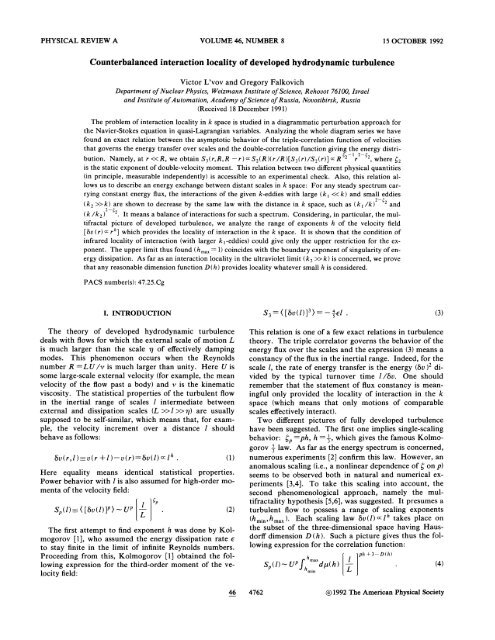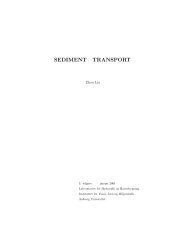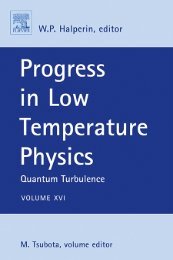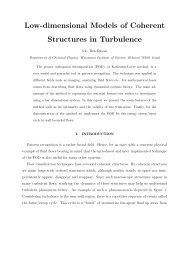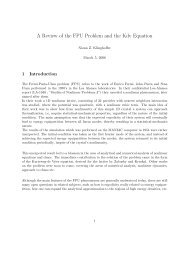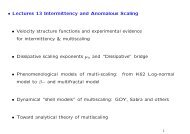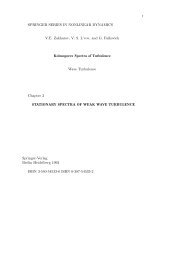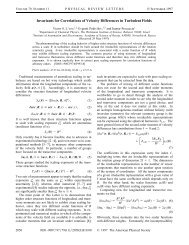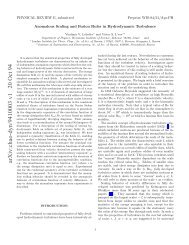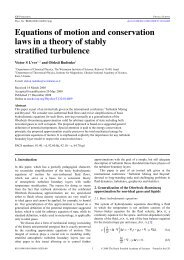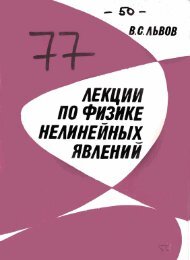Phys. Rev. A - Victor S. L'vov Home-page - Weizmann Institute of ...
Phys. Rev. A - Victor S. L'vov Home-page - Weizmann Institute of ...
Phys. Rev. A - Victor S. L'vov Home-page - Weizmann Institute of ...
Create successful ePaper yourself
Turn your PDF publications into a flip-book with our unique Google optimized e-Paper software.
PHYSICAL REVIEW A VOLUME 46, NUMBER 8 15 OCTOBER 1992<br />
Counterbalanced interaction locality <strong>of</strong> developed hydrodynamic turbulence<br />
<strong>Victor</strong> <strong>L'vov</strong> and Gregory Falkovich<br />
Department <strong>of</strong> Nuclear <strong>Phys</strong>ics, <strong>Weizmann</strong> <strong>Institute</strong> <strong>of</strong> Science, Rehovot 76100, Israel<br />
and <strong>Institute</strong> <strong>of</strong> Automation, Academy <strong>of</strong> Science <strong>of</strong> Russia, Novosibirsk, Russia<br />
(Received 18 December 199 1)<br />
The problem <strong>of</strong> interaction locality in k space is studied in a diagrammatic perturbation approach for<br />
the Navier-Stokes equation in quasi-Lagrangian variables. Analyzing the whole diagram series we have<br />
found an exact relation between the asymptotic behavior <strong>of</strong> the triple-correlation function <strong>of</strong> velocities<br />
that governs the energy transfer over scales and the double-correlation function giving the energy distri-<br />
46 COUNTERBALANCED INTERACTION LOCALITY OF.. . 4763<br />
Here the measure <strong>of</strong> the different scalings dp( h) is sup-<br />
posed to be smooth. The exponent 3 - D (h ) defines the<br />
probability <strong>of</strong> finding the scaling exponent h. The mul-<br />
tifractality concept also gives a power behavior for all<br />
correlation functions: since in (4) the smallest exponent<br />
dominates in the limit <strong>of</strong> 2-0, then the correlators<br />
behave by the power laws<br />
though with an anomalous scaling defining by an unknown<br />
function D (h ).<br />
Both above pictures imply (3) and are based thus on<br />
the locality assumption. The locality problem was studied<br />
previously for the single-scaling Kolmogorov spectrum<br />
only. It is done in the framework <strong>of</strong> the directinteraction<br />
approximation [7] and in the entire perturbation<br />
series without any cut<strong>of</strong>f [8]. Here we solve the general<br />
locality problem without any assumptions about the<br />
steady spectrum except (3) and scale invariance.<br />
To analyze the mechanism <strong>of</strong> interaction balance, one<br />
should know the triple moment for noncoinciding arguments<br />
like<br />
In Sec. 11, we find the asymptotic behavior <strong>of</strong> (6) for one<br />
distance being much smaller than others. To find such<br />
asymptotic behavior, one should use the exact formulas<br />
for the correlation functions which are obtained by<br />
analyzing the entire perturbation series (without any<br />
cut<strong>of</strong>f) for the Navier-Stokes equation. Neither the di-<br />
mensional approach nor finite closures could give the<br />
correct answer in this case. We thus find the second [in<br />
addition to (3)] exact relation for the asymptotic behavior<br />
<strong>of</strong> the triple-correlation function. This relation allows us<br />
to give in Sec. I11 the whole analysis <strong>of</strong> the interaction lo-<br />
cality. In particular, we analyze the multifractal picture<br />
directly in the framework <strong>of</strong> the Navier-Stokes equation.<br />
The possible presence <strong>of</strong> different exponents gives rise to<br />
a new question in the locality consideration. Is it possible<br />
that locality is violated in the ultraviolet region for<br />
sufficiently small h and in the infrared region for large h?<br />
We show that locality analysis gives the upper restriction<br />
for exponent h.<br />
11. EXACT RELATION<br />
FOR THE TRIPLE-CORRELATION FUNCTION<br />
A natural way to analyze an interaction locality is to<br />
consider the Navier-Stokes equation (NSE) for in-<br />
compressible fluid flow in the k representation [2]:<br />
where r is the Eulerian vertex and P is the transverse pro-<br />
jector.<br />
Equation (7) is nonlinear. Multiplying it by different<br />
powers <strong>of</strong> velocity v (k, t ) and averaging, one could obtain<br />
the equations for the correlation functions <strong>of</strong> the velocity<br />
field. Time evolution <strong>of</strong> the nth correlation function is<br />
governed by some integral with the correlation function<br />
<strong>of</strong> order n + 1. As a first step, one could consider the<br />
simultaneous double-correlation function<br />
which describes the energy density over scales:<br />
E (k, t) = k 'F( k, t ). Here angular brackets denote tur-<br />
bulent ensemble averaging. The equation for Fa8 is as<br />
follows:<br />
Here F'~' is the simultaneous triple correlator:<br />
From the physical viewpoint, the interaction locality<br />
means that the main effect on the behavior <strong>of</strong> given k-<br />
eddies (eddies <strong>of</strong> spatial scale 1 /k) arises because <strong>of</strong> their<br />
interaction with eddies <strong>of</strong> the same order <strong>of</strong> size.<br />
Mathematically, it means that the main contribution to<br />
the integral (10) arises from the regions where q and p are<br />
<strong>of</strong> order <strong>of</strong> k which means the convergence <strong>of</strong> the integral<br />
(10) and nothing else. There exist different definitions <strong>of</strong><br />
locality separating, for instance, the case with the main<br />
contribution from the region (k/2,2k) from the case<br />
with that <strong>of</strong> the region (k /5,5k), etc. To our mind, such<br />
a difference is <strong>of</strong> no principal importance for turbulence<br />
theory, whereas the difference between the case <strong>of</strong> a convergent<br />
integral in (10) (where one could define the energy<br />
flux in the k space) and the case <strong>of</strong> divergency (where<br />
energy is transferred nonlocally) is a qualitative one. Our<br />
definition <strong>of</strong> locality is usual in the general theory <strong>of</strong> tur-<br />
.<br />
bulence 191.<br />
So the main point here is the analysis <strong>of</strong> integral convergence<br />
and, in particular, the question about the convergence<br />
reserve that is the law <strong>of</strong> how the contribution<br />
<strong>of</strong> a distant region in the k space turns into zero while the<br />
distance increases. Interaction <strong>of</strong> k-eddies with q-eddies<br />
<strong>of</strong> much larger scales is defined by the asymptotic behavior<br />
<strong>of</strong> ~'~'(k,~,~;t) at q
4764 VICTOR L'VOV AND GREGORY FALKOVICH 46<br />
viding convergence <strong>of</strong> the integral. It could be shown<br />
that the locality analysis gives the same results for the exponent<br />
interval whatever order n 12 <strong>of</strong> correlation function<br />
is used.<br />
Let us recall the relations between the scaling properties<br />
<strong>of</strong> second and third correlation functions F'~' and<br />
F'~' in the k representation and that <strong>of</strong> S, and Sj in the r<br />
representation. Double correlators are related as follows:<br />
For a power function F'~'( k ) a k -y with 3 < y < 5, the<br />
main contribution to this integral is given by the region<br />
k -- + l/l. Therefore, in the inertial interval where<br />
S,(I)~I~~ we havey=3+f,.<br />
Considering the similar integral for the triple correlators<br />
S3( 1 ) and F'~'( k,q,p ) and assuming the main contributron<br />
to be provided by the region k = q --p -- 1 / I, we<br />
obtain the scaling behavior<br />
F'~'( hk, hq, hp) = h-'~'~)(k,q,p) (13)<br />
in this region. According to the scaling hypothesis for<br />
high-order correlations, we shall assume that relation (13)<br />
is valid for any k,p,q from the inertial interval. For the<br />
third correlator, we thus know the total exponent only:<br />
but not the exponents a and b separately. Therefore, one<br />
should analyze the equation for F'~' following from (7).<br />
It is important to emphasize that to obtain the correct expression<br />
for F'~', one should analyze the entire series <strong>of</strong><br />
perturbation theory (see the Appendix for details).<br />
The main difference between the quasi-Lagrangian and<br />
the conventional (in terms <strong>of</strong> the Eulerian velocity)<br />
descriptions <strong>of</strong> turbulence is that the wave vector k is no<br />
longer preserved in the vertex V, and the functions (9)<br />
and (1 1) become nondiagonal in k [i.e., the correlation<br />
functions are not proportional to 6(k,-k,)]. This is the<br />
result <strong>of</strong> the absence <strong>of</strong> spatial uniformity <strong>of</strong> the theory<br />
due to the explicit dependence <strong>of</strong> the QL velocity (15) on<br />
the coordinate <strong>of</strong> the marked point r,, where sweeping is<br />
precisely eliminated.<br />
It is convenient to develop the turbulence description<br />
in w representation supposing statistical properties to be<br />
invariant with respect to a time shift. We will study<br />
double- and triple-correlation functions <strong>of</strong> velocity field.<br />
By analogy with (9) and (1 11, let us introduce these func-<br />
tions for the QL velocities u(r,; k, w) in the (w,kj repre-<br />
sentation:<br />
The main problem here is due to the fact that integrals<br />
over k diverge in terms <strong>of</strong> Eulerian velocity v even for the<br />
Kolmogorov spectrum. According to Kraichnan [lo],<br />
such a divergency is caused by the strong sweeping <strong>of</strong> the<br />
small eddies by the largest ones, so it is irrelevant to the<br />
problem <strong>of</strong> the locality <strong>of</strong> dynamic interaction providing<br />
energy cascade due to an energy exchange between the<br />
eddies.<br />
Following Ref. [8], we will use the quasi-Lagrangian<br />
(QL) velocity u(r,,r,t) in order to eliminate the sweeping<br />
in the vicinity <strong>of</strong> some space point r,:<br />
If the velocities <strong>of</strong> all particles <strong>of</strong> the fluid are identical,<br />
the above QL velocity naturally coincides with the La-<br />
grangian velocity <strong>of</strong> fluid particle along the actual trajec-<br />
tory. It should be noted that Eq. (15) contains no approx-<br />
imations, since it is just the definition <strong>of</strong> the function<br />
v( r, t 1. Formula (15) itself represents a precise relation<br />
between the Eulerian and quasi-Lagrangian velocities. In<br />
terms <strong>of</strong> the quasi-Lagrangian velocity, one can adequate-<br />
ly construct a theory <strong>of</strong> turbulence [8,11], and, in particu-<br />
lar, find the asymptotic behavior <strong>of</strong> the triple-velocity-<br />
correlation function.<br />
The motion equation for u(r,,;k,t ) may be derived by<br />
substituting (15) into (7). The resulting equation has the<br />
form <strong>of</strong> the initial Navier-Stokes equation (7) but with<br />
another dynamic vertex V describing only the dynamic<br />
interaction <strong>of</strong> eddies in the QL approach to the theory <strong>of</strong><br />
turbulence [8,11] (see also the Appendix):<br />
It is important to emphasize that simultaneous correla-<br />
tion functions <strong>of</strong> the order n for QL velocities F'"' coin-<br />
cide with the same functions <strong>of</strong> Eulerian velocities F:"'<br />
and do not depend on r, [8,11]. Therefore, we will con-<br />
sider the problem <strong>of</strong> triad interactions in the QL ap-<br />
proach with the sweeping being eliminated completely.<br />
Using then the above-mentioned coincidence, we will ob-<br />
tain a conclusion about the behavior <strong>of</strong> simultaneous
46 COUNTERBALANCED INTERACTION LOCALITY OF. . . 4765<br />
correlation functions <strong>of</strong> Euler velocities. In particular,<br />
we will use the following relations for the double- and<br />
triple-velocity-correlation functions:<br />
integrated the expressions (1 8) and (1 9) over all <strong>of</strong> wj .<br />
In order to find an asymptotic behavior <strong>of</strong> the simul-<br />
taneous triple-correlation function <strong>of</strong> Eulerian velocity,<br />
we have analyzed in the Appendix the entire diagram<br />
~~(r~;k,q,o)do/2~=~,(k,q)=~,(k)~(k-~l , (18) series for the triple moment <strong>of</strong> QL velocity. In the<br />
asymptotic limit k
4766 VICTOR L'VOV AND GREGORY FALKOVICH - 46<br />
+ waD /am + . . . into (20) and integrate the additional<br />
terms arising in (21) in the same manner. Finally, we ob-<br />
tain the following corrections to (23):<br />
Here a, and a, are some dimensionless constants, x being<br />
the dynamic scaling exponent (for the Kolmogorov solution,<br />
y = y, x = f ). For multifractal subsets with an arbitrary<br />
h, one could obtain x = 1 - h, since the typical frequency<br />
scales with 1 as 6v(l)/l. We shall demonstrate<br />
below that h 5 1, so x > 0. The account <strong>of</strong> the frequency<br />
dependence gives indeed the small corrections in each order<br />
<strong>of</strong> the expansion in k /q. Therefore, we shall use (23)<br />
in the further calculations.<br />
It is important to emphasize here that 6 functions <strong>of</strong><br />
the frequencies in (20) are the same in both terms arising<br />
in (20) after substituting the vertex V. This leads to the<br />
absence <strong>of</strong> a term proportional to kXF(k) in the expansion<br />
(23). So the main term in the asymptotic expansion<br />
<strong>of</strong> triple-correlation function (24) is a k ' -Y@l( q )/q. The<br />
total scaling exponent <strong>of</strong> the triple-correlation function is<br />
y, =7 according to (14). The scaling exponent <strong>of</strong> @,,,(q)<br />
may be thus expressed in terms <strong>of</strong> the scaling exponent y<br />
<strong>of</strong> the double correlator<br />
Let us allow a small digression. It is interesting to<br />
compare z, which one would obtain in the direct-<br />
interaction approximation [7] for the triple-correlation<br />
function, with the above correct answer. In that approxi-<br />
mation (see the Appendix for details)<br />
Using (201, one has in the same way the estimation for<br />
functions @:<br />
Due to the scaling relation 2x +y = 5 [8,11], the same result<br />
for z, could be easily obtained in any (finite) order <strong>of</strong><br />
diagrammatic perturbation theory or under the assumption<br />
that the dynamic vertex V is not renormalized. The<br />
value oCzo coincides with the correct result z =7-y only<br />
on the Kolmogorov solution x = f, y = y. For example,<br />
in the multifractality approach, y > 9, which reflects the<br />
renormalization <strong>of</strong> the vertices for a multifractal turbulence.<br />
We do not know now how it occurs, but we<br />
know the total exponent <strong>of</strong> the triple correlators. So, in<br />
order to find the scaling exponent z <strong>of</strong> large wave vectors<br />
in the triple-velocity correlator, it is necessary to take<br />
into account the entire diagrammatic series which leads<br />
to a renormalization <strong>of</strong> the vertices.<br />
The difference between the initial result <strong>of</strong> Kraichnan<br />
[7] and the present approach is due to the fact that the<br />
direct-interaction approximation is an uncontrolled pro-<br />
cedure. On the contrary, we shall analyze in the Appen-<br />
dix the whole series, find the main contribution into the<br />
triple correlator for q >>k, and prove that the neglected<br />
terms are small by parameter (k/q)11'3. Our approach is<br />
thus controlled with a really small parameter. We get a<br />
result different from that <strong>of</strong> [7]: interactions with distant<br />
scales are counterbalanced for a real spectrum with a<br />
constant energy flux (whatever 4, it has), not only for the<br />
Kolmogorov solution as in the direct-interaction approxi-<br />
mation.<br />
Now let us briefly explain the physical meaning <strong>of</strong> the<br />
final expressions (23) and (24). The triple-correlation<br />
function (11) with one wave number being small in com-<br />
parison with two others corresponds to the triple-<br />
correlation function (26) <strong>of</strong> velocity increments between<br />
three points in r space, with one distance being smaller<br />
than two others: r2,=r
46 COUNTERBALANCED INTERACTION LOCALITY OF . . . 4767<br />
ergy exchange (29), and the next term becomes essential.<br />
This term is even under k -+ - k and is proportional to<br />
@,( k )q ,-y. Therefore, the infrared convergence is<br />
defined by the integral<br />
However, for the ultraviolet integral (301, the first term<br />
in (23) gives a nonvanishing value:<br />
The vertex I'( k,q,q a k was substituted in both (31) and<br />
(32).<br />
Dividing these integrals by F(k), one obtains the esti-<br />
mate for a typical time <strong>of</strong> the nonlinear interaction <strong>of</strong> the<br />
k-eddy with the largest eddies<br />
which takes place for any reliable model <strong>of</strong> turbulence<br />
(the exponents <strong>of</strong> low-order correlators are close to those<br />
<strong>of</strong> the single-scaling Kolmogorov picture 6, =p /3).<br />
IV. INTERACTION LOCALITY<br />
IN THE MULTISCALING MODEL<br />
We assumed the interaction to be local in k space for<br />
the multifractal picture. Now it is necessary to check<br />
that it is true for each h subset. Mathematically, the in-<br />
tegral convergence means that one could change the or-<br />
der <strong>of</strong> integrations over dh and dq. One may represent in<br />
(33) the double-correlation function as an integral over<br />
exponents h as in (4):<br />
and a typical time <strong>of</strong> the interaction with the smallest eddies<br />
Substituting this into (33), we find that the integral is proportional<br />
to the negative power <strong>of</strong> L (i.e., it converges) if<br />
h,,, < 1. It is interesting to note that the dimension<br />
D (h) does not arise in the final expression, since qL = 1<br />
for the lower limit <strong>of</strong> integration. The probability <strong>of</strong><br />
finding the largest eddy is equal to unity for all h subsets.<br />
As one can see, the interaction with small scales produces Multifractality plays its role for small scales only.<br />
some turbulent viscosity since r,, a k ,.<br />
-<br />
The<br />
condition h < h,,, = 1 means that the maximal velocity<br />
First, we substitute the simple single-scaling Kolmo- gradients 6u (q ) /q qh -' become singular at R co for<br />
gorov solution into (33) and (34) to demonstrate how it<br />
all h subsets.<br />
converges. In this case, ~ (k)ak-"/~ and @(q)aq-10/3<br />
For the ultraviolet integral (34), we could not represent<br />
by virtue <strong>of</strong> (25). Calculating (33) and (341, we determine<br />
@(q) as an integral over dh, since it is proportional to the<br />
that the contributions <strong>of</strong> distance regions in the k space<br />
ratio <strong>of</strong> two correlation functions F3(q)/F(q) [see (25)<br />
into the integral (10) governing energy exchange behave<br />
and (28)]. So the locality analysis for the interaction <strong>of</strong><br />
as ( k~)-~/~ and (kq)-4/3. That law was previously obk-eddies<br />
with much smaller scales could give us only the<br />
tained by Kraichnan, and it demonstrates the locality <strong>of</strong><br />
condition (35) and nothing else. It gives no restrictions<br />
the simple Kolmogorov solution. It is worthwhile to note<br />
for the possible values <strong>of</strong> exponent h. Indeed, it deals<br />
that the contributions <strong>of</strong> small and large scales decrease<br />
only with the exponent <strong>of</strong> the double-correlation funcwith<br />
the distance by the same law. The same is true for a<br />
tion, which is defined as min[2h - D (h) + 31 and not by<br />
general local steady spectrum (not necessarily with the<br />
the minimal value <strong>of</strong> h. The point is that D (h) decreases<br />
Kolmogorov exponent), carrying constant energy flux.<br />
while h decreases, so however slow (for small h) the drop<br />
Indeed, in the general multifractal picture, we have<br />
<strong>of</strong> the correlation function is in k space, the decrease in<br />
y =c,+ 3. The exponent <strong>of</strong> @ is defined by (25) as<br />
the probability <strong>of</strong> finding the small eddy from that h subz<br />
=7-y =4-5, due to the flux constancy, which fixes<br />
set provides the interaction locality.<br />
the exponent if the triple-correlation function. There-<br />
One could explain the physical meaning <strong>of</strong> the above<br />
fore, F(q) = qS2+3 while @(q) = q4-C2. Substituting these locality analysii in the following way. The aforemeninto<br />
(33) and (341, we obtain integrals that behave in the tioned locality means that a typical interaction time<br />
same way independently <strong>of</strong> the value <strong>of</strong> 6,: (k~)"-~ and r( k, k') for the eddies <strong>of</strong> the same order <strong>of</strong> size should be<br />
(kr1f-52. The coincidence <strong>of</strong> the laws <strong>of</strong> decreasing con- much larger than ri,( k, 1 /L ) and ruv( k , 1 /q) The first<br />
tributions from the largest and smallest scales was first time could be estimated as a turnover time for the k-eddy<br />
pointed out in [12] for Kolmogorov-like spectra <strong>of</strong> wave<br />
turbulence. Such a coincidence means that in a stationary<br />
spectrum, the contributions to interaction <strong>of</strong> all<br />
scales, from small to large ones, are balanced [12,9]. It<br />
from the h subset (we put k = k')<br />
also means that for a spectrum with constant flux, the The time <strong>of</strong> an infrared interaction is estimated as being<br />
dynamical interaction either converges at k -0 and co or necessary for the k-eddy to be distorted noticeably by the<br />
diverges at both limits. It is worth noting that such a bal- velocity difference AuL(k) <strong>of</strong> the large-eddy flow on the<br />
ance does not necessarily hold for any cascade steady<br />
spectra. For example, it is not the case for a turbulence<br />
system with two (or more) motion integrals giving<br />
different steady spectra, as in two-dimensional turscale<br />
<strong>of</strong> the small one. It is thus as follows:<br />
bulence.<br />
It is important that this time is defined by the scale <strong>of</strong> the<br />
The locality condition is thus<br />
k-eddy only and is independent <strong>of</strong> its velocity (that is,
4768 VICTOR L'VOV AND GREGORY FALKOVICH 46<br />
-<br />
which h subset the eddy belongs to). Comparing T( k) and In conclusion, we would like to say that the range <strong>of</strong><br />
rir, we obtain the above locality criterion h < h,,, = 1. exponents evidently should be restricted from below. We<br />
The consideration <strong>of</strong> an ultraviolet interaction is a bit suppose that the high-order correlation functions behave<br />
more complicated. The interaction <strong>of</strong> the given k-eddy as if they are determined by the positive exponents only<br />
with small kl -eddies (with 7 l k >> k) should provide [3,4]. What we have shown here is that such a restriction<br />
some turbulent viscosity v,: should be given not by locality analysis but by the other<br />
rU,(k,kl,h )=[k2vT(kl,h )]-I .<br />
conditions ie.g., incompressibility [13]).<br />
The value <strong>of</strong> viscosity should depend on the turbulence APPENDIX: DIAGRAMMATIC APPROACH<br />
level at the place and the time under consideration. This TO THE ASYMPTOTIC BEHAVIOR<br />
means that the viscosity depends on the velocity <strong>of</strong> the OF THE HIGH-ORDER-VELOCITY-<br />
k-eddy which generates the small eddies. The rate <strong>of</strong> en- CORRELATION FUNCTIONS<br />
ergy dissipation<br />
1. The quasi-Lagrangian diagram technique<br />
be to the local<br />
gives the viscosity<br />
flux sik8u3(k7h). It<br />
Following [8,11], we use the quasi-Lagrangian (QL) velocity<br />
u(ro,r, t) (15) in order to eliminate the sweeping in<br />
the vicinity <strong>of</strong> some space point ro. In the (t,k) representation<br />
these equations reproduce the original Navier-<br />
Stokes equations (7) but with another vertex V [Eq. (1611,<br />
which was called dynamic [8].<br />
The detailed analysis <strong>of</strong> the Wyld diagram technique<br />
(DT) for quasi-Lagrangian velocities was given in [8,11].<br />
Such a diagram technique was formulated [8] in terms <strong>of</strong><br />
the double-velocity-correlation function for the QL velocand<br />
the following estimate for r,,:<br />
ities u( r,; k, o) (l7j and Green's function:<br />
Determining the ultraviolet locality, we obtain where f is an extraneous force. Let us introduce the<br />
r/r,,= (k, /k )'-"
Here Zy6!ro; w, q, p ) and OY6( r,; w, q, p ) are mass operators<br />
with inflowing momentum q and outflowing momentum<br />
p. These mass operators are represented by an<br />
infinite series <strong>of</strong> one-particle irreducible diagrams, which<br />
have the same form as in the Wyld diagram technique for<br />
Eulerian velocities [15,2] but the Eulerian vertices r (7)<br />
have to be replaced by the dynamic vertices V (16):<br />
Here Z2, is some functional <strong>of</strong> 2n vertices V, n double-<br />
velocity-correlation functions F, and (2n - 1 ) Green's<br />
functions G and G*; 02, is a functional <strong>of</strong> 2n vertices V,<br />
(n + 1) functions F, and 2( n - 1) functions G and G *.<br />
2. Diagram series for the triple-correlation function<br />
There are many various approximate methods for cal-<br />
culating the double-velocity-correlation function, which<br />
F(~)<br />
l,a& (r0;~1,~2,~3,ki,k~,k3) = x { 1 -<br />
COUNTERBALANCED INTERACTION LOCALITY OF. . . 4769<br />
gives a reasonable result in the inertial interval: the<br />
Kolmogorov-Obukhov spectrum [2,16]. The triple-<br />
velocity-correlation function is the first object that can-<br />
not be calculated in the conventional approaches without<br />
complete elimination <strong>of</strong> the sweeping. Therefore, it is<br />
reasonable to use the quasi-Lagrangian approach for<br />
analyzing triple or higher momenta <strong>of</strong> the velocity field.<br />
In the QL diagram technique, the triple-correlation<br />
function (17) is represented by an infinite series <strong>of</strong> dia-<br />
grams that has the same form as in the Wyld diagram<br />
technique for Eulerian velocities [15,2], though with the<br />
dynamic vertices V (1 6):<br />
Here F~~',, is some functional <strong>of</strong> (2n + 1) vertices V,<br />
(n +2) double-velocity-correlation functions F, and<br />
(2n + 1) Green's functions G and G*. In Kraichnan's<br />
direct-interaction approximation F(~'=F(,~', where<br />
0<br />
(A6)<br />
12,s<br />
Here x( denotes the sum <strong>of</strong> three terms with the following replacement <strong>of</strong> the exponents: 1-2-3-1 and<br />
lc2c3cl. The rules for reading these diagrams are as usual. They may be recollected by comparing the diagrams<br />
for ~ 1 with ~ ' the corresponding analytical expressions:<br />
The diagrams for Fi3' and Fi3' look like<br />
+[term with 1+2-+3-+l , k-q-p-k]<br />
+[term with lt2t3tl , kcqcpek]J . (A7)
4770 VICTOR L'VOV AND GREGORY FALKOVICH - 46<br />
Note that the integral <strong>of</strong> the expression (A7) over a,,<br />
a,, and 0 3 gives [according to (19)] the simultaneous<br />
correlation function and it has to be proportional to<br />
ti( k+q+p). Unfortunately, this common property is not<br />
satisfied in (A7). The same problem arises under the cal-<br />
culation <strong>of</strong> the simultaneous double-correlation function<br />
for QL velocity. To solve the problem, it is necessary to<br />
discuss some general properties <strong>of</strong> the QL technique in<br />
more detail. We have already mentioned that all simul-<br />
taneous correlation functions <strong>of</strong> Eulerian and quasi-<br />
Lagrangian velocities coincide. This fact is reflected in<br />
(1 8) and (19) for double- and triple-velocity-correlation<br />
functions. Fulfillment <strong>of</strong> these general requirements for<br />
In fact, fl'3' is independent <strong>of</strong> r. However, as was stated<br />
above, this property must be fulfilled for the entire series,<br />
but not for each <strong>of</strong> its terms. In principle, F(3) can be<br />
calculated with any r, but in the case <strong>of</strong> a cut<strong>of</strong>f <strong>of</strong> the diagram<br />
series, it is reasonable to do this at rrro because<br />
this is the point where the sweeping has been eliminated<br />
in the best way.<br />
Now let us consider the diagram series (A61 for F'~) in<br />
the asymptotic limit k
is some function <strong>of</strong> kj,oj (j= 1-4) expressed according<br />
to (A10) via complete vertices A, B, and C. In an analyti-<br />
cal form the relation (A13) is represented by the expres-<br />
sion (20). It is very important to note that all lines F de-<br />
pending only on k and w are presented in (A13) explicitly.<br />
The diagrams for D do not contain such lines. Functions<br />
F and G in these diagrams depend on k and o via sums<br />
like k+qf--q--p and w+w,--w,. Function D thus de-<br />
pends on k and o analytically and may be expanded at<br />
COUNTERBALANCED INTERACTION LOCALITY OF. . .<br />
The diagrams (A6), (A8), and (A10) for ~ (~'(k,~,~) may small k and w into series with respect to powers <strong>of</strong> k and<br />
be represented in the following form:<br />
w. This point allows us to obtain the asymptotical limit<br />
<strong>of</strong> the triple correlator in the explicit form (24).<br />
The final relations (24) or (28) are exact, since we made<br />
no uncontrolled approximation while analyzing the<br />
Navier-Stokes equation. Of course, using diagrammatic<br />
series (as well as functional integral) is a poorly defined<br />
where<br />
procedure from the viewpoint <strong>of</strong> rigorous mathematics.<br />
Nevertheless, in theoretical physics it could give exact results<br />
in fluid mechanics as well as in quantum-field theory<br />
or statistical mechanics if one analyzes series as a whole<br />
(or, equivalently, the function integral). For example, the<br />
Dyson equation or Ward identities are usually obtained<br />
in that way. Note that the relation obtained is some analog<br />
<strong>of</strong> Ward identities in the field theory.<br />
(All)<br />
We are grateful to V. Lebedev for reading the<br />
manuscript and for valuable remarks. V.L. acknowledges<br />
support from the Meyerh<strong>of</strong>f Foundation at the<br />
<strong>Weizmann</strong> <strong>Institute</strong>.<br />
[I] A. N. Kolrnogorov, Dokl. Akad. Nauk SSSR 32, 16 [4] A. Vincent and M. Meneguzzi, J. Fluid Mech. 225, 1<br />
(1941). (1991).<br />
[2] A. S. Monin and A. M. Yaglorn, Statistical Fluid Mechan- [5] G. Parisi and U. Frisch, in Turbulence and Predictability<br />
ics (MIT, Cambridge, MA, 1971), Vols. I and 11. in Geophysical Fluid Dynamics, Proceedings <strong>of</strong> the Inter-<br />
[3] F. Anselmet, Y. Gagne, E. Hopfinger, and R. Antonia, J. national School <strong>of</strong> <strong>Phys</strong>ics "Enrico Fermi," Course<br />
Fluid Mech. 140, 63 (1984). LXXXVII, Varenna, 1984, edited by M. Ghil, R. Benzi,
4772 VICTOR L'VOV AND GREGORY FALKOVICH<br />
and G. Parisi (North-Holland, Amsterdam, 19851, p. 84.<br />
[6] T. Helsey, M. Jensen, L. Kadan<strong>of</strong>f, I. Procaccia, and B.<br />
Sraiman, <strong>Phys</strong>. <strong>Rev</strong>. A 33, 1141 (1986).<br />
[7] R. H. Kraichnan, J. Fluid Mech. 9, 1728 (1966).<br />
[8] V. I. Belinicher and V. S. <strong>L'vov</strong>, Zh. Eksp. Teor. Fiz. 93,<br />
533 (1987) [Sov. <strong>Phys</strong>.-JETP 66, 303 (198711.<br />
[9] V. Zakharov, V. <strong>L'vov</strong>, and G. Falkovich, Kolmogoroc<br />
Spectra <strong>of</strong> Turbulence (Springer-Verlag, Berlin, 199 11, Vol.<br />
1.<br />
[lo] R. H. Kraichnan, J. Fluid Mech. 6,497 (1959).<br />
[I 11 V. S. <strong>L'vov</strong>, <strong>Phys</strong>. Rep. 207, 1 (1991).<br />
[I21 G. Falkovich, Zh. Eksp. Teor. Fiz. 93, 172 (1987) [Sov.<br />
<strong>Phys</strong>.-JETP 66,97 (198711.<br />
[I31 U. Frisch, Proc. R. Soc. London, Ser. A 434, 31 (1991).<br />
[I41 V. E. Zakharov and V. S. <strong>L'vov</strong>, Izv. Vyssh. Uchebn.<br />
Zaved. 18, 1470 (1965).<br />
[I51 H. W. Wyld, Ann. <strong>Phys</strong>. (N.Y.) 14, 143 (1961).<br />
[16] M. Lesieur, Turbulence in Fluids (Kluwer, London, 1990).


